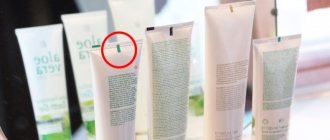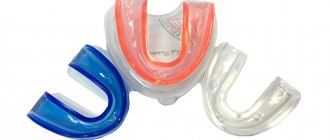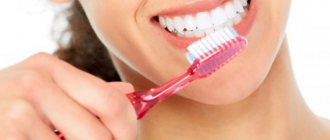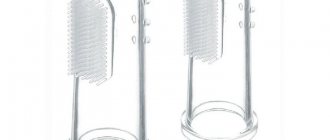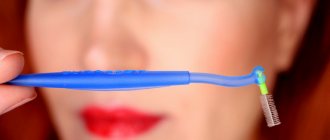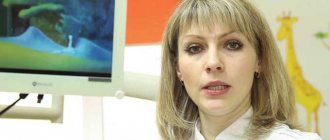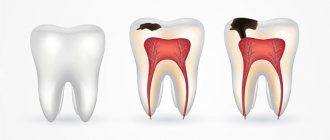On the Internet you can find many videos on how to properly tighten the plate for the upper and lower teeth using a key that is specially designed for this. Parents have a lot of questions about how to perform all the manipulations effectively and without harming the child.
After installing the structure, the orthodontist will show you how to tighten the mechanism and develop an individual schedule that should be followed throughout the entire therapeutic course, with possible deviations depending on the clinical picture and dynamics. If adults are vigilant and strictly control the entire treatment process, a positive result will not be long in coming, and after 1.5-2 years the little patient will be able to boast of straight teeth.
What are dental plates?
An orthodontic plate for teeth is a removable structure made of soft plastic and wire. This device is made individually from hypoallergenic materials and is not traumatic to the oral mucosa. Plates for straightening teeth can be either single- or double-jawed, depending on the diagnosis. They can be supplemented with a “hand-shaped process”, which is used to move only one tooth. The device may also contain a retraction arch designed to correct the position of the front teeth. Separate types of plates for teeth are Brückle and Frenkel devices. Look at the photo below to see what the plate looks like on your teeth.
Operating principle
The action of a removable dental plate is based on redistributing the load on the jaws and restoring the equilibrium between the muscles of the masticatory apparatus. An orthodontic device consists of 3 main elements:
- Bases made of soft hypoallergenic plastic, partially or completely covering the palate;
- Metal elements - hooks fixing the teeth and an arc connecting them;
- A mechanism for regulating the force of pressure on the jawbone and teeth - a screw located in the central part of the base.
On the left are records, on the right is how to tighten a record
Due to the need to most accurately match the configuration of the base to the shape of the palate, orthodontic plates are made only individually, based on impressions of the patient’s jaws.
Types of dental plates
Depending on the diagnosis, the doctor determines the types of dental plates. In some cases, only a plate is installed for the teeth of the lower jaw. This design refers to mechanically operating devices, that is, its action depends on the elasticity of the component parts. They use the force of an orthodontic screw, wire, ligature, or rubber ring. To increase space in the dentition at the stage of mixed dentition, an expanding plate for the teeth of the upper jaw, based on a Bertoni screw, is also used. The screw is installed on the working model of the jaw in the deep part of the dome of the palate so that it is parallel to the occlusal plane. This design needs to be tightened from time to time; we will tell you how to do this a little later.
Plastic surgery for lower jaw teeth
Upper jaw plate
When should a plate be placed on a child’s teeth?
The dental plate is not suitable for adult patients. This is an exclusively children's orthodontic device. First of all, plates for straightening teeth in children are used up to 12 years of age. During this period, there is active growth of the jaws, which makes it possible to quite effectively correct the bite, eliminate crowding and remove other occlusion anomalies. When the jaw bones have formed, it is only possible to align the teeth within the dentition. And correction of bite in adult patients is only possible with the help of braces and orthognathic surgery. In this regard, parents should not delay visiting a specialist, even if it is a preventative one, if treatment is not required. Orthodontists recommend placing a plate on a child’s teeth to achieve the following treatment goals:
- correction of jaw shape;
- regulation of jaw growth;
- correct placement of incisors in a row;
- increasing or decreasing the size of the sky.
Clinic orthodontist - Ph.D. Ryabtseva Alla Alexandrovna
Work experience 12 years. Candidate of Medical Sciences with teaching experience. Doctor of the highest category.
Specializes in correcting malocclusions using removable (aligners, plates) and non-removable (braces) equipment. Successfully applies MEAW multi-loop arc technologies and miniscrews. Works with adults and children (from 3 years old). Successfully uses MEAW multi-loop arch technology, miniscrews and devices for jaw expansion according to Marco Rossa.
In 2008 she graduated from the Stavropol State Medical University, in 2009 from the North-Western State Medical University. I. I. Mechnikova (St. Petersburg), 2011 full-time graduate school, 2013 candidate of medical sciences. Since 2014, assistant at the Department of General Dentistry and Pediatric Dentistry at Stavropol State Medical University. Studied in the USA and Europe.
How to place a plate on a child’s teeth?
Installing plates on children's teeth usually takes several weeks, since they are made individually for each patient. To create a suitable orthodontic appliance, the patient undergoes an X-ray examination, then the doctor takes an impression of the teeth for the plate. After this, plaster models are made, from which the structures are created. Particular attention is paid to the exact match of the surface relief of the gums and the palate - the adjustment takes just over 10 minutes. After this, the child will be able to independently remove and put on the plate on the lower teeth and upper jaw.
Care instructions
The rules for caring for orthodontic plates are quite simple. You need to clean the device daily using a special gel and soft-bristled toothbrushes. The plates should be stored dry in a special container. To avoid the formation of plaque on the surface of the plate, it is recommended to place it in a cleaning solution every few days at night. Tablets for preparing such a solution (Pariodent, Lakalut or Corega) can be purchased at the pharmacy.
After completing the cleaning, it is advisable to lubricate the adjusting screw of the device: apply a drop of any vegetable oil to it, and then turn it a little in one direction or the other.
How long do you wear plates on your teeth and how to wear them?
The main problem with this type of treatment is that children need to wear removable dental plates 22–23 hours a day. The course of treatment can last from a year to a year and a half, with replacement of the structure required every 6 to 8 months. Like any orthodontic device, plates for baby teeth require some getting used to. Children often complain that their teeth hurt from the plate; this is normal. Usually the discomfort disappears 5 to 6 days after installation.
Wearing dental plates often confuses children, but it is worth explaining to the child that they are less noticeable and more comfortable than metal braces, which will have to be worn in adolescence without timely treatment. Children's dental plates are often made of plastic in bright colors so that the child enjoys wearing them.
Useful tips
Because orthodontic plates are foreign bodies, the child may want to have them removed. Parents should keep this under close control. They must explain to their son or daughter that wearing this unpleasant device for a long time is required so that the teeth later look smoother and more beautiful.
If your child removes the plates frequently, the results will be delayed and they will have to wear them longer. The child should carefully monitor dental hygiene, brushing them twice a day. The plate must be removed during the procedures.
Important ! The device must be treated daily with one product, and weekly with another.
How to tighten a dental plate?
The twisting procedure is necessary to increase the load, as well as expand the main surface of the plate, which is installed on the upper jaw. Your doctor will tell you how to tighten the dental plate and how often to do it. The process itself is not too complicated: using a key inserted into the main hole of the screw, one turn is made along the guide arrow on the tooth plate. After this, the child may feel discomfort for some time, but this procedure is necessary to achieve the desired result. In addition, if necessary, the plate can be returned to its previous position by turning back.
Dental plastic with a key for twisting
Device
Before you start adjusting the lock yourself, you need to figure out what the correction device consists of. Standard structure:
- Plastic base that follows the anatomy of the palate and jaws. Solid, durable, but not causing severe discomfort to the child. It comes in different shades, often bright, to appeal to children.
- Wire hooks, which in most cases are attached to the molars.
- Metal arc. It puts pressure on the rows and helps move them in the right direction.
- A screw with a hole located in the center. It is this that is activated and periodically tightened.
- Bright marking arrow indicating the direction for adjusting the device.
How to care for a dental plate?
When wearing a removable structure, the child needs to handle it carefully and avoid damage or loss, as well as properly care for it. You need to remove the plate from your teeth before each meal and be sure to clean it every day with a special brush and gel. It is better to store records in a container. Particular attention must be paid to the little patient’s own oral hygiene. That is why dentists usually give a short lecture to the child, in which they explain all the rules for handling this structure.
Container for dental plates
Possible difficulties
During therapy, certain difficulties may arise, such as:
- The key fails or is lost. The part is very small, so it often happens that it gets lost. There's nothing wrong with that. How to tighten a dental plate for teeth if the key is lost? It can easily be replaced with any sharp object, for example, a sewing needle, knitting needle, or unfolded paper clip.
- Breakage of a metal part. This does not happen often, but when it does happen, it is with devices on the lower jaw due to the smaller size of the plastic base. In such a situation, you cannot do without the help of an orthodontist; you need to go to him as soon as possible. If you repair the record incorrectly, you will damage the device. Only a specialist can assess the scale of the problem and advise further course of action. In some cases, it is necessary not to repair, but to completely change the orthodontic structure.
Plates or braces for teeth?
This choice cannot stand - dental plates and braces have different functions. The former affect the entire dentition, the latter have a wide range of functions and solve various orthodontic problems: from the curvature of individual teeth to malocclusion and crowding. Also, the plate cannot be placed if the child has developed traumatic periodontitis, in which a fracture of the cortical plate of the tooth is possible. However, these two devices can be used in combination - first the child will be given a plate, and then braces.
Number and time of revolutions
The adjustment is designed specifically to ensure that the gums, jaws and teeth move apart not at once, but gradually. At the very beginning of treatment, this process has not yet started, so no visible result can be expected. How much you need to twist the mechanism is determined solely by the orthodontist.
In the first stages you will only need a few turns. If you do this abruptly, the little patient will experience pain and other discomfort. In addition, the risk of complications, including injury, increases significantly. Therapy will not be accelerated if more revolutions are allowed than necessary in a certain period.
Usually, at the very beginning, twisting is not needed. This is due to the fact that the child is just beginning to adapt to the plate, and unnecessary pain will only worsen the adaptation.
After the adaptation period, expansion can be performed. When the first results become visible, the device is gradually tucked in more and more. As a rule, it is necessary to tighten the arches after 2-3 weeks.
The clinic will draw up a correction schedule, which it is recommended to adhere to. At each appointment, the effectiveness of treatment is assessed, and the regimen may be slightly modified.
In difficult cases, the doctor takes over the function of pulling only himself. This is indicated if the dentition changes unevenly.
Towards the end of the therapeutic course, the intervals increase, this helps to better consolidate the result. At the last stage, there is no need to twist the plate, this will make the bone structures stronger and more stable.
The cost of a dental plate in Moscow
The average cost of dental plates for children in Moscow varies from 8 to 15 thousand rubles. Do not forget that the design requires periodic correction and replacement, so visits to the doctor must be included in the total cost. You should also take into account other factors that affect the price, for example, the level of pediatric dentistry and the qualifications of specialists. In any case, you shouldn’t go after cheapness; the cost of dental plates for children should not be too low - the child’s health is more expensive.



